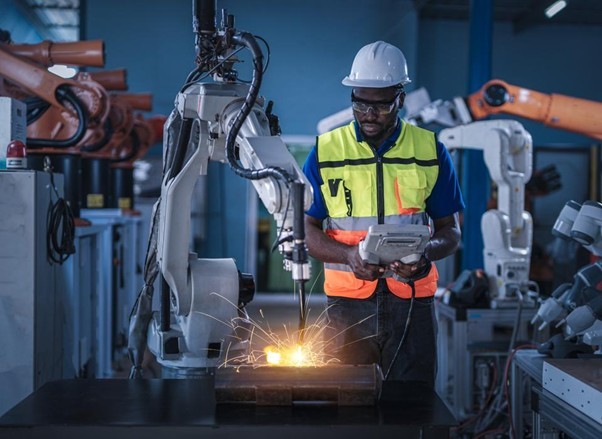The Future Of Manufacturing: Technology Trends For 2025 And Beyond

(Source: forbes.com)
Prioritizing Sustainability With Green Software Engineering
Sustainability in manufacturing now goes beyond just physical operations—software has become a crucial driver of environmentally friendly practices. In 2025, efforts will center around creating and implementing digital tools that support manufacturers in reaching carbon neutrality, cutting down waste, and improving energy efficiency.
More manufacturers are using software to monitor operations in real time, enabling better oversight of energy usage, emission levels, and waste output. This advancement allows for dynamic adjustments that reduce inefficiencies and unnecessary resource use.
Cloud computing is another strong example of sustainable software’s potential. According to Accenture, shifting to public cloud services could reduce emissions to the same extent as removing 22 million cars from the road. As a result, adopting cloud technology helps manufacturers lessen their environmental impact while also enhancing data management capabilities.
Furthermore, Gartner forecasts that by 2027, 30% of major global companies will incorporate software sustainability into their non-functional requirements, a significant rise from under 10% in 2024. This trend shows a growing acknowledgment of software’s contribution to environmental initiatives.
One innovative tool making waves is the digital twin—a virtual model of a physical asset, process, or system. These simulations allow manufacturers to test and refine operations digitally, leading to smarter, greener decisions by reducing resource use and waste before changes are physically implemented.
AI Powering Innovation And Growth In Manufacturing
Artificial intelligence is reshaping the manufacturing sector, with 93% of manufacturers recognizing it as a key driver of innovation and growth in 2025, according to a Deloitte report. AI is being integrated into several aspects of manufacturing, from intelligent production lines and enhanced products and services to strategic business decision-making. At present, smart manufacturing makes up 51% of AI applications in the industry, as companies turn to AI to automate operations, boost quality control, and reduce machine downtime.
Globally, countries are adopting AI through different approaches. For instance, many businesses in Japan are following a step-by-step plan to embed AI powered by data across various industries. Their strategy includes increasing public adoption and establishing an interconnected AI ecosystem spanning multiple sectors. This worldwide commitment underscores AI’s transformative potential in the manufacturing space.
From personal experience, I’ve seen how AI can dramatically improve manufacturing outcomes. One standout project we worked on at Accedia last year involved supporting a client facing frequent, unexpected equipment breakdowns. We developed a predictive maintenance system using machine learning and computer vision to provide real-time insights into equipment conditions. This solution enabled early detection of issues, preventing major disruptions and keeping production running smoothly. It’s one of many examples where AI has proven its ability to enhance operational efficiency and reliability—a trend I’ve consistently observed in similar implementations.
IoT Paving The Way For Smarter, More Connected Manufacturing
As we move deeper into the digital era, the Internet of Things (IoT) is revolutionizing manufacturing by transforming production lines into smart, adaptive systems that automate tasks, optimize resources, and boost efficiency.
For many manufacturers, IoT is already a reality that’s reshaping operations. Airbus, for instance, uses IoT-enabled tracking to oversee key assets during production, building digital twins for real-time monitoring across facilities in France, Germany, and the U.K. This approach reduces operational blind spots, helps manage delays, and enhances tool tracking—ultimately improving inventory control and operational performance.
By 2025, digital factories will be central to innovation, with 67% of industrial manufacturers already progressing in their transformation journey. To fully realize the benefits of smart manufacturing, companies must integrate their operational technology (OT) with information technology (IT) systems. While this convergence is essential for maximizing the value of IoT and related innovations, it also increases exposure to cyber threats. As more devices become interconnected, securing them against potential breaches becomes a crucial concern.
Decentralized Manufacturing: Increasing Agility And Resilience
In response to inflation, geopolitical instability, and growing environmental, social, and governance (ESG) expectations, manufacturers are increasingly adopting decentralized manufacturing to build more robust supply chains. By spreading production across various locations, companies can lower transportation expenses, meet regional market needs more quickly, and enhance overall supply chain resilience.
Microfactories—compact, flexible production facilities—are becoming increasingly prevalent and versatile. For instance, electric vehicle manufacturers can establish microfactories near key markets to reduce logistics costs and respond more swiftly to customer demands. However, decentralizing production also presents challenges, such as managing coordination across multiple sites and striking a balance between consistent standards and localized customization.
Still, emerging Industry 4.0 technologies like artificial intelligence, the Internet of Things (IoT), and 3D printing are helping to overcome these obstacles. These innovations boost visibility, efficiency, and risk mitigation, making decentralized manufacturing more practical. Though it’s not without its complexities, early adopters can gain a competitive edge by using advanced technologies to create agile, adaptive production systems.
Conclusion
The path forward for manufacturing is rooted in innovation and flexibility. As the industry continues to transform, businesses that prioritize cutting-edge technologies and sustainability will be better positioned to seize new opportunities. By welcoming innovation instead of resisting it, companies can set themselves up for lasting success in an increasingly fast-paced and competitive global landscape.
Reference:




Comments :